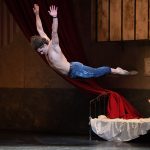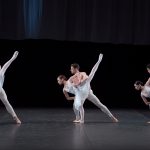Robert Tanitch reviews Lest We Forget at the Barbican Theatre, London, EC2
To mark the centenary of the outbreak of World War 1 Tamara Rojo, artistic director of English National Ballet, asked three choreographers to create three ballets. Her aim, she said, was to challenge any stereotypical public preconception about ENB.
The Barbican Theatre is the right theatre for such a premiere and such a challenge. The programme, a major event and a landmark in English National Ballet’s history, is a memorial, a lament, a requiem to the 10 million dead. There are many striking images, particularly in the ensemble work.
In Liam Scarlett’s No Man’s Land, performed to music by Franz Liszt, the men are in the trenches whilst the women are in the factories making munitions and packing explosives. Both groups, when they are together and when they are apart, carry the weight of loss and grief.
In Russell Malaphant’s Second Breath the sound is sometimes provided by repeated rifle fire. A field of soldiers sway in the breeze, waiting, it seems, to be blown to smithereens. There is so much death.
The men climb on to each other’s shoulders only to climb and fall backwards again and again and again and again. There is no need for a quote from Dylan Thomas. The image says it all. If a quote were needed Wilfred Owen would be a more appropriate choice.
Akram Khan’s Dust opens with a dying soldier, his mutilated body writhing in agony on the ground; trying to lift himself up, he constantly fails. Behind him the corps becomes a human rope chain in which the joined arms rise, curve and buckle. It is a sculptural image of enormous power.
I am not sure why George Williamson’s Firebird is included in this particular programme. Unlike Maurice Bejart, who managed to turn his version of Firebird into a political statement, Williamson’s choreography makes no statement on War whatsoever and it feels it shouldn’t be there.
To learn more about Robert Tanitch and his reviews, click here to go to his website




